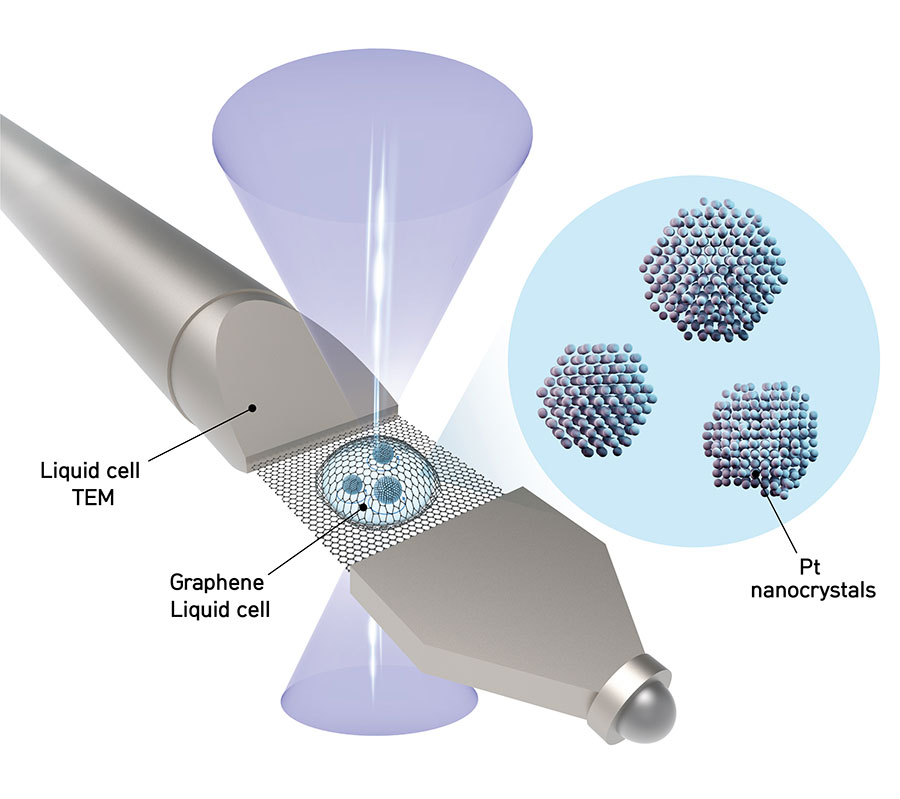Apr 3 2020
A close observation of three-dimensional (3D) renderings of platinum nanoparticles shows just an accurately drawn 3D picture. Nanotechnologists involved in a new study reported in the Science journal would observe far more than that.
 Obtaining 3D structures at atomic resolution in a liquid. The schematic shows a liquid sample contained between two sheets of graphene—the thinnest, strongest material known. Nanoparticles in the liquid freely rotate while a transmission electron microscope takes thousands of images of the nanoparticles. The images are then analyzed by the authors’ software to determine the location of every atom in each nanoparticle. Image Credit: Institute for Basic Science.
Obtaining 3D structures at atomic resolution in a liquid. The schematic shows a liquid sample contained between two sheets of graphene—the thinnest, strongest material known. Nanoparticles in the liquid freely rotate while a transmission electron microscope takes thousands of images of the nanoparticles. The images are then analyzed by the authors’ software to determine the location of every atom in each nanoparticle. Image Credit: Institute for Basic Science.
The arrangement of atoms in a material governs whether it catalyzes chemical reactions or inhibits any molecular response. The main aim of nanotechnology is focused on the potential to design and develop materials atom by atom, thus enabling researchers to manipulate their properties in any specified scenario.
But atomic imaging methods have not been adequate to identify the accurate three-dimensional atomic arrangements of materials in a liquid solution, which would allow researchers to understand the behavior of materials in day-to-day life, for example, in blood plasma or water.
A new analytic technique with the potential to resolve the 3D structure of individual nanoparticles at atomic-level resolution has been reported by scientists at the Center for Nanoparticle Research of the Institute for Basic Science (IBS, South Korea), in collaboration with Dr Hans Elmlund at Monash University’s Biomedicine Discovery Institute in Australia and Dr Peter Ercius at Berkeley Lab’s Molecular Foundry in the United States.
It is possible to derive the 3D atomic positions of individual nanoparticles with a precision of 0.02 nm, which is six times smaller than hydrogen—the smallest atom. Put differently, this high-resolution technique involves detecting individual atoms and their arrangement within a nanoparticle.
The scientists have named their development 3D SINGLE (Structure Identification of Nanoparticles by Graphene Liquid cell Electron microscopy) and made use of mathematical algorithms to extract 3D structures from a set of 2D imaging data obtained by one of the most powerful microscopes on Earth. Initially, a nanocrystal solution is interspersed between two graphene sheets both with a thickness of just a single atom.
If a fish bowl were made of a thick material, it would be hard to see through it. Since graphene is the thinnest and strongest material in the world, we created graphene pockets that allow the electron beam of the microscope to shine through the material while simultaneously sealing the liquid sample.
PARK Jungwon, Assistant Professor, School of Chemical and Biological Engineering, Seoul National University
PARK is one of the corresponding authors of the study. The team obtained movies of each nanoparticle that freely rotated in liquid at the rate of 400 images per second, using a high-resolution transmission electron microscope (TEM). Then, they applied their reconstruction technique to combine the 2D images into a 3D map illustrating the atomic arrangement.
By locating the accurate position of each atom, researchers can observe how the nanoparticle developed and its interaction in chemical reactions.
The researchers characterized the atomic structures of eight platinum nanoparticles—platinum is the most precious of all the valuable metals, used in several applications like catalytic materials for energy storage in petroleum refinement and fuel cells. Although all of the particles were produced in a single batch, they exhibited significant differences in their atomic structures that influence their performance.
Now it is possible to experimentally determine the precise 3D structures of nanomaterials that had only been theoretically speculated. The methodology we developed will contribute to fields where nanomaterials are used, such as fuel cells, hydrogen vehicles, and petrochemical synthesis.
Dr KIM Byung Hyo, Study First Author
Specifically, this technique can quantify the strain on the surface atoms and the displacement of atoms of individual nanoparticles. The analysis of strain using the 3D reconstruction enables defining the active sites of nanocatalysts at the atomic level, which will allow the structure-based design to optimize the catalytic activities. The technique could also help enhance the performance of nanomaterials.
According to Director HYEON Taeghwan of the IBS Center for Nanoparticle Research, “We have developed a groundbreaking methodology for determining the structures that govern the physical and chemical properties of nanoparticles at the atomic level in their native environment.”
The methodology will provide important clues in the synthesis of nanomaterials. The algorithm we introduced is related to new drug development through structure analysis of proteins and big data analysis, so we are expecting further application to new convergence research.
HYEON Taeghwan, Director, IBS Center for Nanoparticle Research
This research is jointly funded by the Institute for Basic Science (IBS), Samsung Science and Technology Foundation (SSTF), and the Molecular Foundry (U.S. Department of Energy (DOE) Office of Science User Facility).
3D Reconstructions of Individual Nanoparticles
3D Reconstructions of Individual Nanoparticles. 3D density maps, atomic position maps, and strain maps of eight reconstructed nanocrystals show critical differences between the individual particles. Image Credit: Institute for Basic Science.
Source: https://www.ibs.re.kr/eng.do